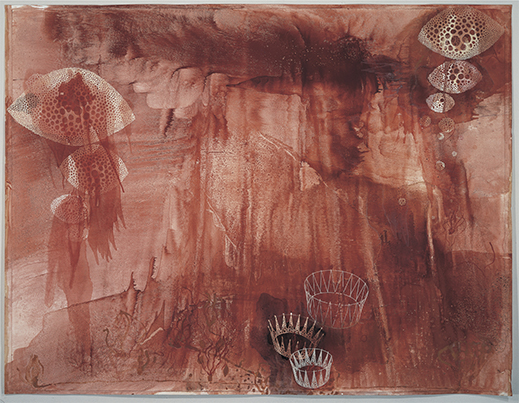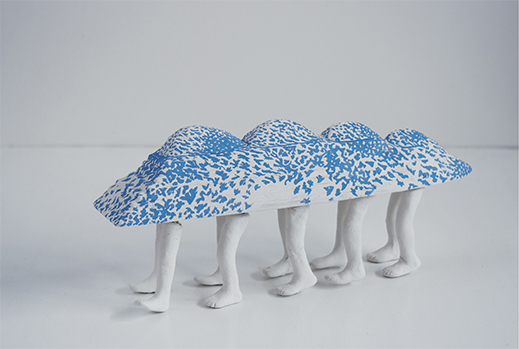 |
Focus features two in-depth reviews each month of fine art, architecture and design exhibitions and events at art museums, galleries and alternative spaces around Japan. The contributors are non-Japanese residents of Japan. |
|
|
 |
 |
 |
Pistils and Fission: Keisuke Yamaguchi's Singular Artistic Vision
Christopher Stephens |
 |
Calder Hall Ship - ENOLA GAY (1994) |
A number of recent exhibitions have attempted to sum up Japanese art of the 1980s with a focus on the resurgence of painting and the rise of installations. Surveys of this type invariably exclude anyone whose work fails to fit into prescribed notions of the era. See Keisuke Yamaguchi. Born in 1962, the Hyogo Prefecture native is very much an artist of that time, but whereas many of his contemporaries opted for a light or humorous approach, Yamaguchi gravitated toward something more serious, as evidenced by the Keisuke Yamaguchi: Backing Forward exhibition, running through 4 September at the Hiroshima City Museum of Contemporary Art.
While not overtly political, Yamaguchi's work often includes an undercurrent of impending crisis. He came to the theme of nuclear power early on, and for a time adopted reactor components, some resembling beehives, and plutonium transport vessels as his standard motifs. The large 1994 print Calder Hall Ship - ENOLA GAY, for example, depicts the black silhouette of a ship laden with cooling towers (a visual reference to Calder Hall, the world's first commercial nuclear facility) teetering on the edge of a vortex. Scattered throughout the space are dark ovular bodies studded with holes that recall lotus seed pods with a slightly sinister air. White versions of these organisms returned the next year in Elephant Cage (Red), rising up through a wash of blood-red pigment above a trio of crowns. Except that, as the title makes clear, these are actually "elephant cages," the colloquial term for the huge antennas that were installed by the U.S. military in Aomori Prefecture during the Cold War to intercept radio transmissions.
 |
|
Elephant Cage (Red) (1995) |
Yamaguchi's practice is also distinguished by an awe of the natural world, as illustrated by his frequent use of flowers. This was in part inspired by Goethe's concept of the Urpflanze, an elusive archetypal plant that the German writer viewed as the basis for all subsequent vegetation. Yamaguchi's Colony (Pseudocarp) is a large painting encased in a thick wooden frame that sits on the floor rather than hanging on the wall. White, purple, and yellow splashes are accented with fluid cell-like membranes and stencils of a textbook flower diagram. This alone makes for a ravishing picture. But the small acrylic cubes that line the sides of the frame, containing seed pods, resin, and beeswax, add another dimension to the work.
It was also in 1997, during a residency in Germany, that Yamaguchi launched his Cassette Plant series. These simple yet ingenious constructions are made of empty cassette-tape cases, each of which holds a flower, sprig, or leaf that the artist (sometimes with the help of workshop participants) gathered from the local area. The cases serve as the building blocks for a wall or other structure installed next to the window of a gallery space to radiate light and warmth.
 |
|
 |
|
|
|
Left: Colony (Pseudocarp) (1997). Right: One of the works in Yamaguchifs Cassette Plant series, Light Tree / Particle and Edge of the Mountain (2005) |
Arks have been a constant theme in Yamaguchi's work since the early '90s. They symbolize biblical salvation, promising an escape from our bleak future on Earth, and counteract Yamaguchi's ominous black ships, which are loaded with plutonium, carbon, and other foreboding cargo. The newest model of ark is a large public sculpture, Walking Ark, originally built for the Setouchi Triennale in a fishing port on Ogijima island. Topped with four white-and-blue-speckled mounds and powered by five pairs of legs, the vessel is apparently headed for Iwaki, Fukushima Prefecture, an area that was devastated by the Great East Japan Earthquake and subsequent tsunami in 2011. To an artist who had been preoccupied with nuclear imagery for years, the series of explosions and meltdowns that occurred at the Fukushima Daiichi Nuclear Power Plant in the wake of the quake were hugely significant, prompting Yamaguchi to begin an ongoing daily journal. Along with hand-copied news items related to the disaster, these notebooks, collectively known as After the Quake, are packed with colorful illustrations, some of which have an oddly upbeat appearance considering the subject matter.
 |
|
Walking Ark Maquette (2012-2013) |
Recent years have seen the artist turn to stunning wall-sized paintings. One of these, Ur-listening: Celestial Map across the Sea T, unites many of Yamaguchi's longtime interests (botanical elements, microscopic organisms, walking arks, etc.) with a large humanoid face, one of his latest fixations. It is tempting to see these many-eyed creatures, some with three faces connected horizontally and topped with a matching cat head, as some kind of mutant species born out of radioactive fallout. (Yamaguchi has spoken about the formative influences of Godzilla, Astro Boy, and the Cuban Missile Crisis.) But they might just as easily be derived from Buddhist art, such as the statue of the guardian deity Ashura at Nara's Kofuku-ji temple that sports three faces and six arms. (Yamaguchi has said that his grandfather was a Buddhist priest and that he increasingly finds himself drawn to Buddhist teachings.)
Backing Forward, the title of the exhibition, alludes to the fact that human beings are fated to reflect on the past while moving helplessly into the future. It might also suggest that Yamaguchi remains unsure of his own artistic direction. If his previous efforts are any indication, however, one can only imagine that the best lies ahead.
 |
|
Ur-listening: Celestial Map across the Sea T (2014-2015) |
All images © Keisuke Yamaguchi, courtesy of the artist. |
 |
 |
Christopher Stephens
Christopher Stephens has lived in the Kansai region for over 25 years. In addition to appearing in numerous catalogues for museums and art events throughout Japan, his translations on art and architecture have accompanied exhibitions in Spain, Germany, Switzerland, Italy, Belgium, South Korea, and the U.S. His recent published work includes From Postwar to Postmodern: Art in Japan 1945-1989: Primary Documents (MoMA Primary Documents, 2012) and Gutai: Splendid Playground (Solomon R. Guggenheim Museum, 2013). |
|
 |
|